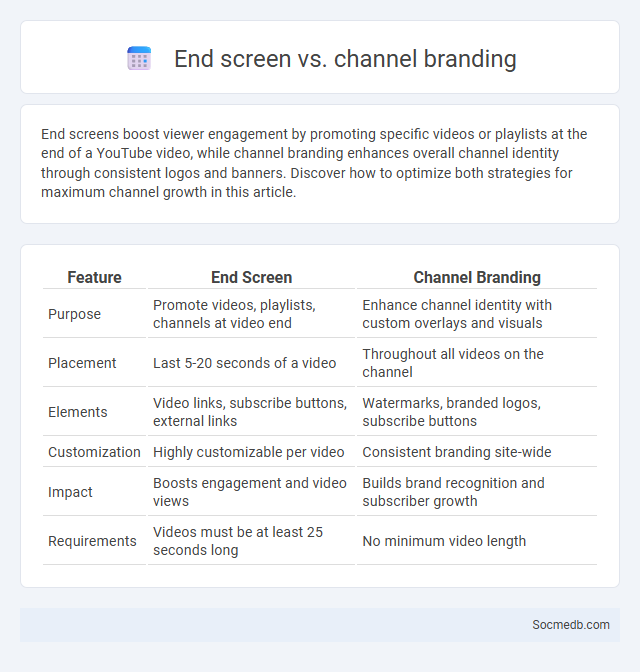
Photo illustration: End screen vs Channel branding
End screens boost viewer engagement by promoting specific videos or playlists at the end of a YouTube video, while channel branding enhances overall channel identity through consistent logos and banners. Discover how to optimize both strategies for maximum channel growth in this article.
Table of Comparison
| Feature | End Screen | Channel Branding |
|---|---|---|
| Purpose | Promote videos, playlists, channels at video end | Enhance channel identity with custom overlays and visuals |
| Placement | Last 5-20 seconds of a video | Throughout all videos on the channel |
| Elements | Video links, subscribe buttons, external links | Watermarks, branded logos, subscribe buttons |
| Customization | Highly customizable per video | Consistent branding site-wide |
| Impact | Boosts engagement and video views | Builds brand recognition and subscriber growth |
| Requirements | Videos must be at least 25 seconds long | No minimum video length |
Introduction to YouTube End Screen and Channel Branding
YouTube End Screens enhance viewer engagement by promoting your channel's videos, playlists, or subscribe button during the last 5-20 seconds of your video, increasing the chance of longer watch time and subscriber growth. Channel Branding consists of customizing your YouTube channel through consistent logos, banners, and watermarks that reinforce Your brand identity and make your content easily recognizable. Utilizing both features strategically helps maximize audience retention and builds a loyal viewer base on YouTube.
What is an End Screen?
An end screen is a customizable feature on social media platforms, particularly YouTube, designed to promote viewer interaction at the conclusion of a video. It typically includes elements such as video thumbnails, subscription buttons, and external links, encouraging users to watch more content or engage with the channel. Optimizing end screens can significantly increase viewer retention, channel growth, and overall engagement metrics.
What is Channel Branding?
Channel branding is the process of creating a unique and consistent identity for your social media platform, including visual elements like logos, color schemes, and banners, as well as consistent messaging and tone. This cohesive branding helps your audience recognize and connect with your content, increasing engagement and loyalty. Effective channel branding sets your profile apart in crowded social media spaces and strengthens your overall digital presence.
Key Features of End Screens
End screens on social media platforms like YouTube enhance viewer engagement by promoting key actions such as subscribing to your channel, watching related videos, or visiting external websites. These features include customizable templates, clickable elements, and mobile-friendly designs to maximize interaction. Leveraging end screens effectively helps You increase viewer retention and drive traffic to targeted content or links.
Core Elements of Channel Branding
Effective social media channel branding centers around consistent visual identity, including logos, color schemes, and typography, which reinforce brand recognition and trust. Crafting a unique brand voice that reflects the company's values and resonates with the target audience enhances engagement and loyalty. Optimizing profile elements such as usernames, bios, and cover images ensures clarity and professionalism, contributing to a cohesive and memorable brand presence.
End Screen vs Channel Branding: Purpose and Impact
End Screen and Channel Branding serve distinct purposes in social media content strategy, with End Screen designed to boost viewer engagement by promoting specific videos, playlists, or calls to action at the conclusion of a video, while Channel Branding enhances overall channel identity through consistent visual elements like logos and color schemes. Your use of End Screens can increase viewer retention and subscription rates by directing attention to targeted content, whereas strong Channel Branding builds long-term recognition and trust among your audience. Both tools impact your channel's growth by optimizing user experience and reinforcing brand presence across multiple videos.
Optimizing Viewer Engagement with End Screens
End screens on social media videos significantly boost viewer engagement by promoting related content, encouraging subscriptions, and driving website visits. Strategically placing clickable end screen elements within the last 5-20 seconds maximizes viewer interaction and increases retention rates. Analytics tools help identify optimal end screen designs and placements, enhancing overall channel growth and audience loyalty.
Strengthening Identity through Channel Branding
Channel branding on social media plays a crucial role in strengthening identity by creating a consistent visual and thematic presence that resonates with the target audience. Utilizing unique logos, color schemes, and tone of voice helps establish brand recognition and fosters trust among followers. Consistent content strategy across platforms reinforces the brand's values and mission, ultimately enhancing audience engagement and loyalty.
Best Practices: Combining End Screens and Channel Branding
Implementing end screens in social media videos effectively boosts viewer engagement by promoting channel branding and video recommendations. Strategic placement of clickable elements like subscribe buttons and video links during the final 5-20 seconds enhances subscriber growth and watch time metrics. Consistent use of branded visuals and calls-to-action within end screens reinforces brand identity and encourages repeated interactions across multiple platforms.
Conclusion: Choosing the Right Strategy for Your Channel
Selecting the right social media strategy hinges on understanding your target audience's preferences, engagement patterns, and content consumption habits. Tailoring your approach to align with platform-specific algorithms and trends maximizes visibility and interaction rate. You secure sustained growth and meaningful connections by consistently refining your strategy based on analytics and user feedback.
 socmedb.com
socmedb.com